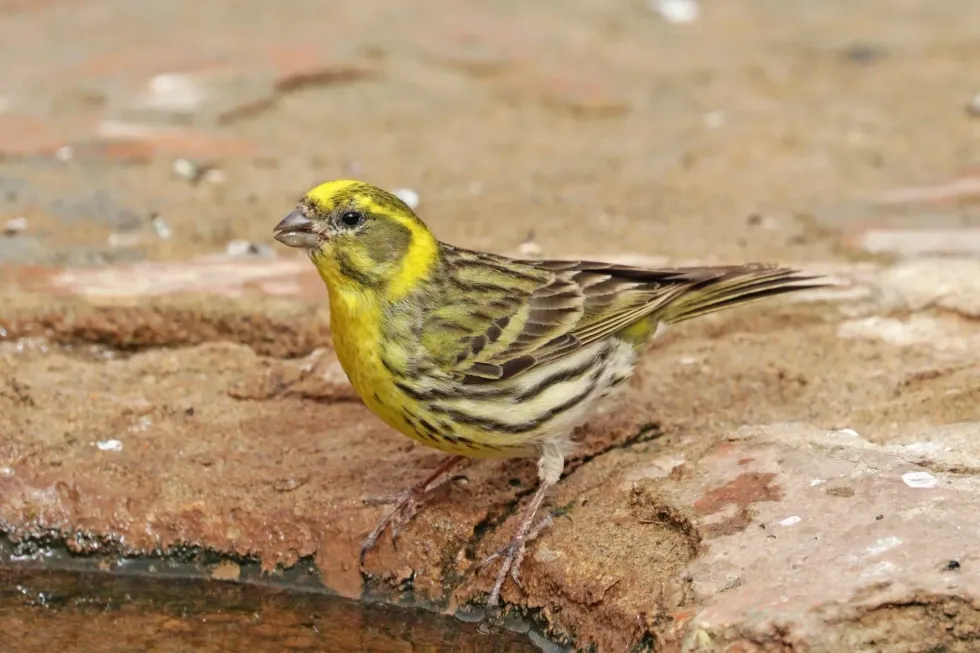The European serin (Serinus serinus) belonging to the family Fringillidae, generally known as serin is the smallest species of the family Fringillidae. They are mostly found in the southern and central parts of Europe. Unlike other Aves class or family members, these small species are more of a city bird than a wild bird species.
The European serin is an extremely light-weighted yellow creature with distinctive features like a yellow wing which makes it easier to spot them in the local spaces.
They are an average of 4.3-4.7 in (11-12 cm) in length with a noticeable yellow face and breast and the back is heavily streaked with white and gray strokes with a yellow rump and breast.
The upper parts of the body are seen to have patches of grayish green, making them look extremely colorful.
These yellow birds are partially migrant birds and every breeding season they are known to be flying for mating. Read on to know more interesting facts about these birds.
If you liked the European serins, you might want to check out these red kite facts and grouse facts for more.
European Serin Interesting Facts
What type of animal is a European serin?
European serin (Serinus serinus) is a bird. It belongs to the family of Fringillidae (finches).
What class of animal does a European serin belong to?
The European serin belongs to the Aves class of animals. They are a songbird very commonly found in Mediterranean countries.
How many European serins are there in the world?
Aaccording to the International Union for Conservation of Nature, the European serin is listed under the section of Least Concern and so currently has a population range of 4.5-7.4 million.
Where does a European serin live?
The European serin is generally found across southern and central Europe and in the eastern parts of North Africa. Even though they are not migratory birds they are known to be flying towards the south during the breeding season.
What is a European serin's habitat?
These small European birds are known to be the inhabitants of the open woodland, cultivation areas, orchards, or the local gardens and parks of the cities.
Who does European serin live with?
The Europe-based singing bird is generally known to be living in pairs and not seen in large numbers. They are mostly monogamous and on average pair up once or twice in a single year to mate. They sometimes form loose groups to forage.
How long does a European serin live?
These small finches species are known to have a very short life span that ranges to an average of two to three years only.
How do they reproduce?
The Europe-based small species have a fascinating method of reproducing. Even though they have an origin in northern Europe, this yellow bird breeds across southern Europe.
They have a breeding range across southern and central Europe and pair up once or twice every year, particularly for mating. In every breeding season, they produce three to five individuals on an average where the male looks for shelter.
The female bird has an alteration in the diet during the time of pregnancy where instead of feeding on seeds and buds, they feed on invertebrates for proper nutrition and nourishment.
What is their conservation status?
According to the research section of the International Union for Conservation of Nature, the European serin comes under the list of Least Concern. 4.5-7.4 million active birds are living at the moment and hence, they are not globally threatened and are not considered to be an endangered species.
European Serin Fun Facts
What does European serin look like?
The European serin is an extremely small and vibrant creature with few prominent features. They go up to 4.7 in (12 cm) in length and are heavily streaked in the upper parts of the body.
They have a yellow rump and breast and a noticeable pair of yellow wings. Apart from yellow, they have a grayish green hue at the back. They have white stripes on their mouth that ends in a small and sharp beak that has a combination of black and white on it.
How cute are they?
Needless to say, these birds are extremely cute and the prominent and vibrant colors make them look even more attractive. This species of finches have a bright yellow breast and dark grayish greenback making them look very colorful.
How do they communicate?
The European serin is a singing bird by nature and mostly communicates by chirping in the daytime.
How big is a European serin?
The European serin, a close relative to the Atlantic canary, is known to be the smallest member of the finches family. They have an average weight of 0.2-0.4 oz (5.6-11.3 g) and an average length of 4.3-4.7 in (11-12 cm) and are almost half the size of an American robin which is also an omnivore by nature.
How fast can a European serin fly?
Even though it is the smallest finch in Europe, these small birds have a wingspan of 7.4-8.6 in (18.7-21.8 cm) on average and fly comparatively faster during the times of migration from northern to southern Europe. However, their exact flight speed is not known.
How much does a European serin weigh?
According to the fact that the European serin (Serinus serinus) are the smallest members of the finch family, they are extremely lightweight in nature and have an average weight of 0.2-0.4 oz (5.6-11.3 g) just like strawberry finches.
What are the male and female names of the species?
Like other Aves class or family members, these adult finches species are generally addressed as 'cock' in the case of the male serin and as a 'hen' in the case of the female serin.
What would you call a baby European serin?
Baby European serins are usually called chicks.
What do they eat?
The European serin (Serinus serinus), relative to the Atlantic canary, is mostly a vegetarian feeding on buds and seeds. During the breeding season, the female serin feeds on invertebrates for proper nutrition making them omnivorous in nature.
Since they live under a cold climatic condition, at the time of birth, young serins require an adequate amount of liquids for proper hydration and nutrition.
Are they dangerous?
By nature, the serin is a singing bird found in local gardens and parks within the city, so there is no such information of these birds being dangerous in nature. In fact, they often act as food for the larger members of the Aves class or family.
Would they make a good pet?
Considering the fact that these finch species are partly migrant, where in winter they are known to be flying towards the south from central and northern Europe, they are known to not stay in a single location for a long time. Hence, there is no information about the serins being a good pet.
On the other hand, they are found among the localities in the local parks, gardens, and orchards too, so they may be possible to domesticate.
Did you know...
The bird has got this name due to its lemon-colored hue as serin in French is known as lemon-colored.
Surprisingly, these birds have petite round wings making them quite fast during the time of their flight.
Even though they are monogamous by nature, they stay alone during the time of maturation.
Does European serin eat invertebrates?
European serins are mostly found to be feeding on seeds and buds. Only during the breeding season, females are known to rely on invertebrates like worms, flies for nutrition.
How many eggs do European serin lay?
These northern European species have a tendency of pairing up twice a year producing three to five eggs on an average in every breeding season. Their eggs possess a whitish color with spots of a reddish hue on them partially.
Here at Kidadl, we have carefully created lots of interesting family-friendly animal facts for everyone to discover! For more relatable content, check out these lark bunting facts and skimmer facts for kids.
You can even occupy yourself at home by coloring in one of our free printable bird outline coloring pages.










